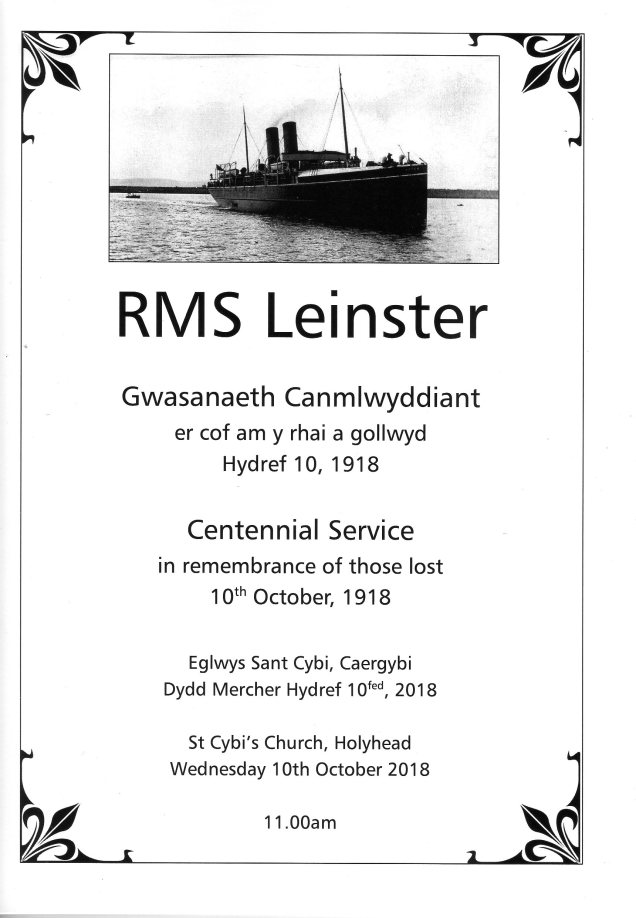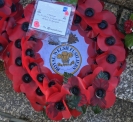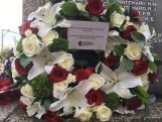
Many will know of Holyhead’s Gill Brownson. She has been writing short stories about some of Holyhead’s Maritime Heritage and performing them at the local Primary Schools under the ‘Those in Peril’ Theatre Education Programme. We asked her why she thought commemorating the loss of RMS Leinster was important and why she chose to tell the story of RMS Leinster‘s Chief Stewardess, Mary Coffey.
This is her reply.
Have you ever heard the phrase, “you couldn’t write it?” Well, you couldn’t. The real drama, of this real story in this real few minutes of history with very real heroes, and yet, it has been my job to do that very thing, to write it, and perform it, in order to give Holyhead school children the opportunity to understand the significance of this tragedy, that happened just a few miles from their shores, the sinking of the RMS Leinster towards the end of the Great War in 1918.
I’m a Holyhead girl, and like all Holyhead children, I grew up with the understanding that there was something special about my town, that the pride we felt came not from wealth, but from the sea, and the way it bound our community together, from the brave kids jumping off the Mackenzie to the night shift coming off the ferries – we all knew somebody who was a part of the sea.
There is a movement in Community Performance, and in more mainstream Theatre, named ‘Verbatim Theatre,’ which is the dramatist’s response to “you couldn’t write it.” The playwright takes documentary evidence and verbal accounts, forming characters from truth in order to relay important moments in history or politics. I’ve been producing Theatre for nearly 20 years, in all sorts of settings, from Monterey Aquarium in Los Angeles to Richmond Theatre in London, often using Verbatim techniques to tell the stories of others – not my own – but this piece feels personal, because, at some level, as part of the Holyhead Community, it is my story, our story and one I feel passionate about telling.
The response from Holyhead’s children, when they hear that, firstly, it’s a true story is one of amazement, but then when they hear that the ‘characters’ in the play went to Ysgol Y Parc, or that Captain Birch lived on Gorse Avenue, their response is what Theatre is for – questions, and lots of them. ‘But what about her Mam and Dad, they’d be sad? Did Louisa Parry have sister and bothers? Did Hannah Owen have children? Indeed, after seeing the play, the children are taking part in an act of remembrance that feels vibrant and sensitive, and, at the same time, their literacy and oracy is spiralling as we place their stimulus to learn squarely at their front door.
The play wouldn’t have been possible without the account of the brave and courageous Chief Stewardess, Mary Coffey, a daughter of our friends in Ireland, and one of the few female survivors that morning. Though a male passenger told her to go straight to the lifeboats, she decided instead to go below and gather as many life jackets as she could. It is a mystery just how many lives she saved, though they will have been numerous. When I was writing the play (with the help of the brilliantly researched ‘Torpedoed’ by Philip Lecane,) my respect for this wonderful woman and so many like her, grew, and has stayed with me since.
She later became a governess and led a reasonably ordinary life, whatever that means, when surely, there’s nothing ordinary about a woman who took a decision to save as many lives as she could before opting to lower herself off the side of a capsizing ship amidst chaos and terror into the freezing cold waters of the Irish Sea and hope to survive. Incredible.
I’m so privileged to have written this story, and performed the role of Mary Coffey for so many children across our little island. I want to thank all the trustees of the Holyhead Maritime Museum, who made the initial application for funding to the Welsh Museums Federation, in order to make this Theatre in Schools project happen, and to the
RMS Leinster Centenary Commemoration Group, who have made it possible for me to share the story with the wider Holyhead Community as the centenary approaches.
Lest we forget.
Gillian Brownson is a professional Creative Writer and Performer working in community and mainstream drama across the North West. Find out more about her work here: http://www.astonishingadventures.co.uk.
She will be performing her story of Mary Coffey at St. Mary’s Hall, Holyhead on Friday, 12th October at 7pm.






















